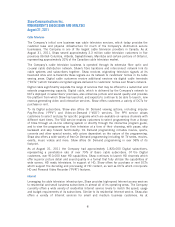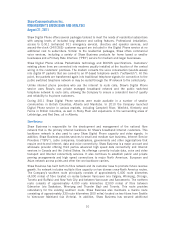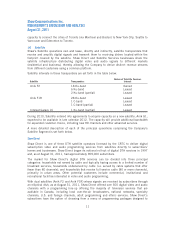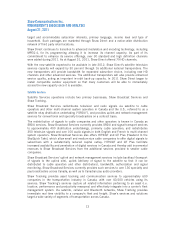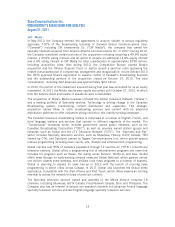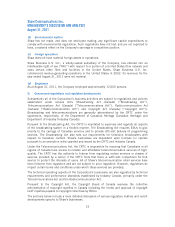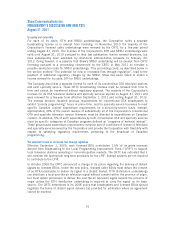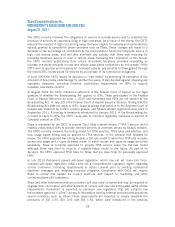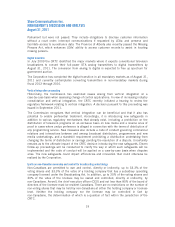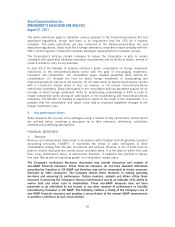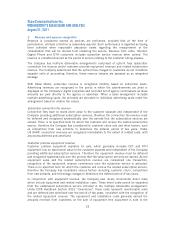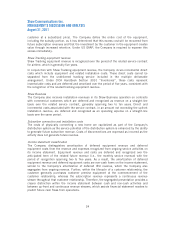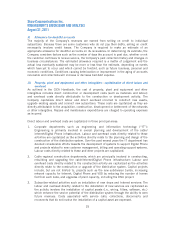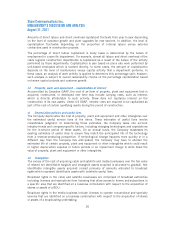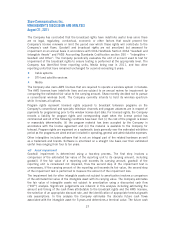Shaw 2011 Annual Report Download - page 22
Download and view the complete annual report
Please find page 22 of the 2011 Shaw annual report below. You can navigate through the pages in the report by either clicking on the pages listed below, or by using the keyword search tool below to find specific information within the annual report.Shaw Communications Inc.
MANAGEMENT’S DISCUSSION AND ANALYSIS
August 31, 2011
The CRTC recently reviewed the obligations of carriers to provide service and to subsidize the
provision of services to customers living in high cost areas. As a result of the review, the CRTC
reduced the number of high-cost serving areas that were eligible for subsidy and eliminated the
subsidy granted to competitive phone providers such as Shaw. These changes will result in a
decrease in the percentage of contribution by the Corporation to fund local telephone service in
high cost serving areas, and will also eliminate any subsidy that Shaw was receiving for
providing telephone service in rural or remote areas. Following the completion of this review,
the CRTC received applications from certain incumbent telephone providers requesting an
increase in subsidy amounts in rural and remote areas where competitors do not operate. If the
CRTC were to approve such requests for increased subsidy, any benefits to Shaw gained through
the initial CRTC review would be reduced by an increase in its contribution obligations.
In June 2009 the CRTC issued its decision on “new media” by extending its exemption of the
provision of new media undertakings for another five years. It also decided against imposing any
regulatory measures, including financial contribution requirements on ISPs, to support
Canadian new media content.
In August 2009 the CRTC initiated a reference to the Federal Court of Appeal on the legal
question of whether the Broadcasting Act applies to ISPs. Shaw participated in the Federal
Court of Appeal Reference on June 1, 2010 and submitted that ISPs are not subject to the
Broadcasting Act. In July 2010 the Federal Court of Appeal issued a decision finding that the
Broadcasting Act does not apply to ISPs. Leave to appeal that decision to the Supreme Court of
Canada was obtained by certain cultural groups, and Shaw’s written arguments were filed in
September 2011. A hearing is tentatively scheduled for January 2012. If the Broadcasting Act
is found to apply to ISPs, the CRTC could seek to introduce regulatory measures in support of
Canadian content on ISPs.
Shaw is mandated by the CRTC to provide Third Party Internet Access (“TPIA”) service, which
enables independent ISPs to provide Internet services at premises served by Shaw’s network.
The CRTC recently reviewed the billing model for TPIA services, TPIA rates and whether, and
how, usage based billing may be applied to TPIA services. In the decision that followed its
review, the CRTC approved two billing models, a flat-rate model in which the TPIA rate includes
access and usage and a capacity-based model in which access and capacity usage are billed
separately. Shaw is currently approved to provide TPIA service under the flat-rate model
although Shaw may elect to move to a capacity-based model in the future. As part of its
decision, the CRTC approved TPIA rates for Shaw that are lower than its previously approved
rates.
In late 2010 Parliament passed anti-spam legislation, which has not yet come into force.
Canada’s anti-spam legislation (CASL) sets out a comprehensive regulatory regime regarding
on-line commerce, including requirements to obtain consent prior to sending commercial
electronic messages and installing computer programs. Compliance with CASL will require
Shaw to review and update its current practices with respect to marketing and other
communications with customers.
Shaw and other telecommunications providers will also need to review and may be required to
upgrade their interception and other systems to comply with new and anticipated lawful access
requirements. Parliament is expected to introduce new legislation that will enhance law
enforcement agencies’ (“LEAs”) access to information held by Internet and telecommunications
service providers, such as Shaw. Those requirements are expected to closely resemble the
provisions of Bill C-50, Bill C-51 and Bill C-52, which were introduced in the previous
18


